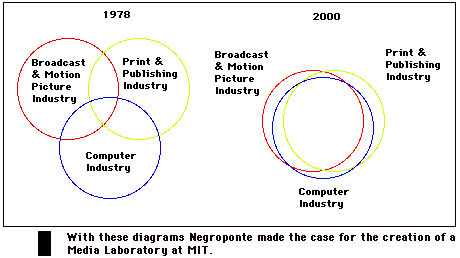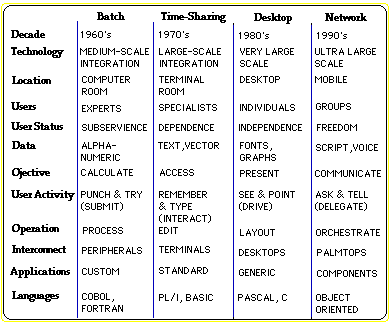as well as adaptability over systems and time.
The development of E-Media has been shaped by a wide variety of forces:
User Friendly Interfaces
People like Douglas Engelbart, Ivan Sutherland and Alan Kay pioneered "friendly" mouse driven graphical user interfaces at places like XeroxPARC. Steve Jobs and Steve Wozniak, et. al finished the job for the general public at Apple Computer 15 years ago. Of course, Bill Gates has also caught up with and surpassed the others at the game eventually.
Conglomerate Meta-Media Emerges
The spread of user friendly computer interfaces took place concurrently with an amalgamation of modern media into a converging digital source. Negroponte, of the MIT Media Lab, is best known for his efforts to publicize and hasten this convergence:
"All communication technologies are suffering a joint metamorphosis, which can only be understood properly if treated as a single subject, and only advanced properly if treated as a single craft." (Brand, 1988)

The convergence of media in digital formats is clearly underway, and media industries are deeply embroiled in heated squabbling about the increasing overlap in their markets. Yet, when you look at Negroponte's famous "2000 Slide" representing the convergence of all types of media, what do you call the area in the middle? It may aptly be called a "meta-media", because, as Alan Kay has pointed out, it is a purely digital form of media that subsumes all others through its ability to emulate them.
Meta-Media Goes Paradigm Shifting
Marshall McLuhan's "Global Village" is materializing right in the middle of Negroponte's primeval soup of developments in communications technologies. The US Congress has insured that massive fiber optic electronic "highways" will be put into place to support and encourage a growing number of these media and communications activities over networks in the future (Gore, 1992).
The soon to be released "Net-Ready Computers" carry with them a revolution in the computing paradigm like that which occurred in the shift from mainframe computers to microcomputers in the 1970s and 1980s. In an article entitled "Networked Computing in the 1990's," Tesler (1991) provided a description of the new paradigm and its relationship to the older paradigms. He also described many larger implications of computing paradigm shifts, including changes in the role of users, the types of data used, and the types of activities performed by users (activities and operations).

Four Major Computing Paradigms (1960s-1990s)
Electronic media authors are beginning to realize that entering the new computing paradigm implies changes in their roles as authors too.
Hyper This and That
Ted Nelson's "hypertext" (later expanded to "hypermedia") is one of the key factors that has influenced the shape of emerging electronic media arriving today. "Hypermedia" refers to databases of linked media of all types. While small semi-functional hypermedia products like Apple's HyperCard were popular ten years ago while computer interfaces were gaining their basic social skills, today, user interfaces are mastering the art of full blown networking. Today's software supports highly integrated functions capable of accessing and manipulating many widely distributed databases of linked text, graphics, sound and video over distributed international networks. The dawn of these environments will allow a robust implementation of the "hyperotic" environment envisioned by the early pioneers in the field (Bush, 1995).
E-This and E-That
Concretely, hyper-meta-media is about to move over high speed communications lines and come at you from your computer and almost every other electronic device around you. Most media companies are moving towards making large databases of electronic media available on the Internet. Specific types of media coded in tightly defined formats moving through traditional channels may soon be a thing of the past as the mental bounds of analog media are overcome. Millions of users already click effortlessly along through huge archives of varied digital media formats with the easy to use interactive interface of the WWW.
While publishers use trendy terms like "Hypermedia", "Multimedia" or "New Media", users don't care much about what to call what is on their screen. As more and more converged media becomes easily available, the issue of what to call it just doesn't keep up.
There is a movement at large to just add the prefix "e-" to all electronic media (e.g. e-book, e-journal and e-mail, the forefather of the movement). This works for now, because in the early days of any revolution the first applications emulate traditional means in a safe and functionally fixed manner. Eventually, these terms will become less apt and more obscure as the electronic referents become more distant from their analog counterparts.
An Open Definition of E-Media
Eskimos have a large number of terms to define the infinite variety of snow they experience, but they still recognize them all as variant forms of the larger category snow.
Instead of defining electronic media by an endless series of obscure or trendy prefixes, it may be clearer to start by creating an open and inclusive definition for the broad converged globally linked electronic media format that is already above the horizon with the single term "E-Media." This term then can subsume the many subtle emerging forms and endless new manifestations, some of which will never have an analog counterpart. The term should also have an open technical definition.
Physical media has been defined by means of the discreet physical form in which it is embodied. A better approach for E-Media is to define it by what it should be, which is the ultimate in human-media interaction by means of a computer. "In some ways, the people who first described hypertext - Bush, Engelbart and Nelson- all had the same vision of hypertext as a path to ultimate human-computer interaction, a vision which is still alive today among hypertext researchers." (Conklin, 1987, p. 20).
The key to this view of E-Media is that it is achieved at the point at which technical limits are overcome, so that authors become free to deal with more abstract issues. In a conversation between Robert Lawler and Mary Hopper, Lawler (personal interview, July 20, 1992) refers to this critical point:
Lawler: I think the example of virtual memory will demonstrate an important point.
Before virtual memory, programmers did horrible things to get programs to run in
limited real memories, but after the introduction of virtual memory, people could
escape from limitations of the machine. The question is one of reaching a critical
point of available resources, to escape from the focus on the issues of design
which are primarily economic and primarily physical, into the focus on design
issues which are primarily logical and organizational in terms of what is coherent.
If this approach to defining E-Media is taken seriously, an open technical definition must include multiple integrated functions to provide flexible support for broad media goals. In addition, the definition must include the attributes that make E-Media usable, as well as adaptable for availability and change in distributed computing environments. Most importantly, the definition must be open to change over time as the requirements needed to achieve the ideal of computer mediated human-media interaction emerge.
At the minimum, this Swiss army knife approach to defining authoring and presentation tools must include seamless usability of multiple functions that are adaptable and stable over time. At the present time, E-Media authors know that there are no tools on the market yet that are truly adequate. However, dedicated authors continue to make do until the real thing comes along.